How do you make $1,000 freelancing online as a web developer or techie?
If you are new to coding, where should you start? What skills do you need to become a freelance developer?
And how do you stand out from the competition when you are just getting started? How can you get hired without any positive reviews on your freelancer profile on a platform such as UpWork?
These are questions I get asked a lot, and for a good reason:
Freelancing is a fantastic way to make money coding – even if you don’t have any previous experience in tech and are still learning your first programming language.
And even if it’s a lot of work to set up a successful freelancing business, your hard work will pay off.
Freelancers can earn more by working less – while enjoying more financial freedom and flexibility in life.
Sound good?
Then you’re in the right place, fellow freelancer!
In this article, I’ll share the exact steps I took back in 2016 and 2017 to earn my first $1,000 from online freelance jobs.
I’ll explain how I chose the skills to learn, and how I earned my first 5-star reviews on the freelancing platform I used.
So, if you are looking for a beginner’s guide on making money freelancing online, keep reading!
Here are a few related article you should check out, too:
- How to Become a Web Developer? Career Tips, Salaries, and Skills
- What Is The Best Programming Language for Freelance Developers?
- 6 Big Benefits of Freelancing for Software and Web Developers
Please note: This post contains affiliate links to products I use and recommend. I may receive a small commission if you purchase through one of my links, at no additional cost to you. Thank you for your support!
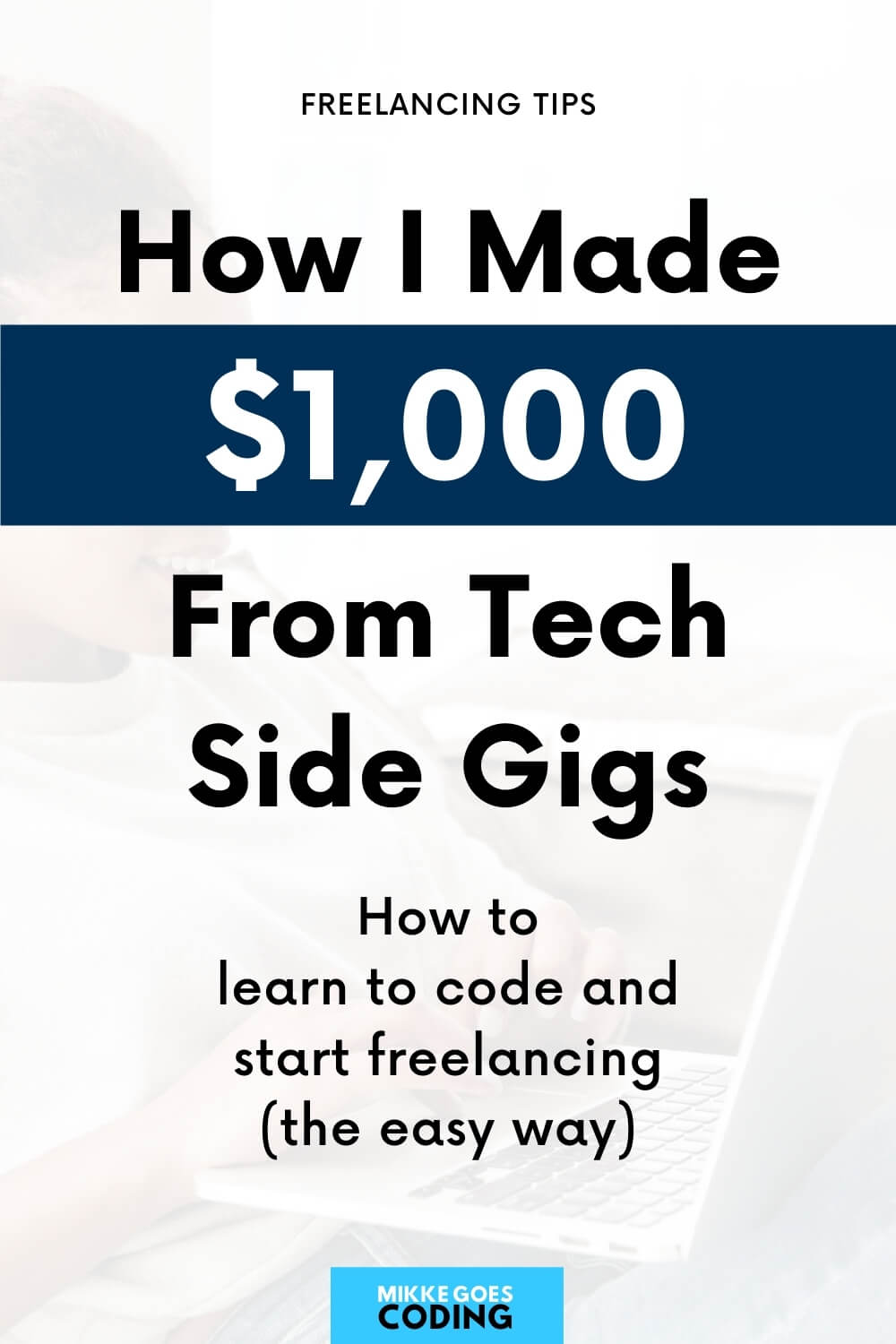
Step 1: Finding in-demand skills to learn
First things first:
If you want to make money freelancing, you need to learn skills that are in demand.
In other words: you need to know how to solve your clients’ problems – otherwise no one will hire you.
When I decided to pursue freelancing, I was terrified.
I didn’t feel confident in my skills at all, but I was curious to give it a try.
At that point, I didn’t like my day job – quite the opposite. I was tired of sitting in pointless meetings all day long, and doing work that didn’t really mean anything to me.
So, without any freelancing experience, I felt like there would be a dozen freelancers out there who could do a better job than me.
Of course, that was true – but I knew I had nothing to lose, so I wanted to give it a shot.
The first thing I did was to find a skill set that I loved learning more about. Also, I wanted to learn skills that I enjoyed working with.
After all, if you have the chance to create the job of your dreams from scratch, why not do something you actually enjoy?
Also, I wanted to learn skills I could use to find work locally, too.
Because the thing is:
There are huge differences in both (1) how quickly you can start making money and (2) how easy it is to actually find jobs.
You can find hundreds of job openings for a specific programming language, but if 95% of them require you to have 5+ years of experience, you’re wasting your time.
To make sure I didn’t learn skills that were difficult to monetize, I needed to do some research. The best way to go about it was to create a profile on a freelancing platform and see what types of jobs were available.
I chose to use UpWork for this. It was super easy to get started with and the platform was great for beginners. I really can’t recommend them enough.
You don’t have a profile on Upwork yet?
No problem. Follow my step-by-step guide on how to create an Upwork profile that gets you hired faster.
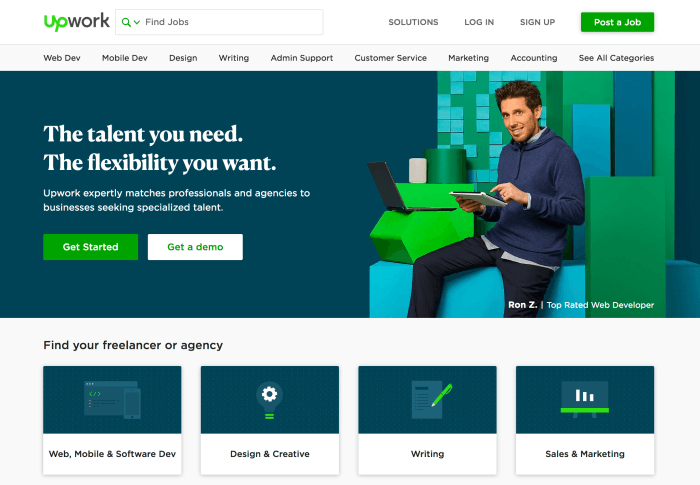
Step 2: Learning front-end web development and WordPress
Why did I learn front-end web development and WordPress?
Because those two areas had the most beginner-level gigs available. Simple as that.
Plus, I enjoyed learning HTML, CSS, and JavaScript. Those are the most essential front-end development languages that allowed me to start making money fairly quickly.
How did I learn those skills?
The Complete Web Developer Course 2.0 on Udemy covered all the basics. I was lucky enough to catch a promo, and the course cost me about $10–15.
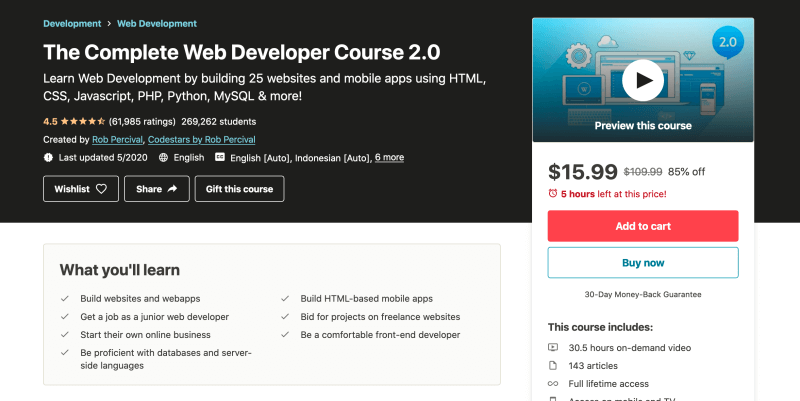
If you’re not familiar yet, check out my Udemy review to learn more about the platform and what courses I recommend.
Throughout the lessons, I learned how to use HTML and CSS to create simple web pages from scratch. Also, the course taught me how to make those pages more interactive and dynamic with a few simple JavaScript tricks.
And finally, the course included a module dedicated to WordPress. It taught me enough about WordPress so that I could get my first website – this blog you’re reading right now – up and running in a couple of weeks.
Related: Why Learn and Use WordPress? 9 Smart Reasons for Beginners
All in all, learning front-end languages and WordPress meant I was playing it safe. I wanted to learn skills that allowed me to find work rather quickly.
At the same time, I was learning skills that I enjoyed working with.
So what languages and tools should you learn to make money freelancing?
Ideally, you want to narrow down your options by:
- Figuring out what’s in high demand.
- Choosing skills you enjoy learning.
Otherwise, you may end up spending months learning things that (1) are difficult to find jobs with, and (2) that you don’t even have fun with. Not good.
Here are a few other resources I used to learn more about front-end development and WordPress:
- freeCodeCamp.org
- The Complete WordPress Website Business Course
- HTML and CSS on Codecademy
Step 3: Uploading projects to UpWork
Next, it was time to make sure I became proficient enough to finish small and simple HTML and CSS jobs for my first clients.
The best way to improve your skills?
Stop watching those online tutorials and start building small projects on your own!
If you are new to coding, start small.
For example, build a super simple web page for yourself with just HTML:
- Add a large H1 heading
- Write a few paragraphs about yourself
- Include a list of the skills you are familiar with
- Add an image, either from an external URL or use your own file
- Create a link to your Twitter account, for example
- Add your contact details at the bottom
You can learn all these basics for free on freeCodeCamp.org. You can sign up and start your first interactive tutorial in 1 minute.
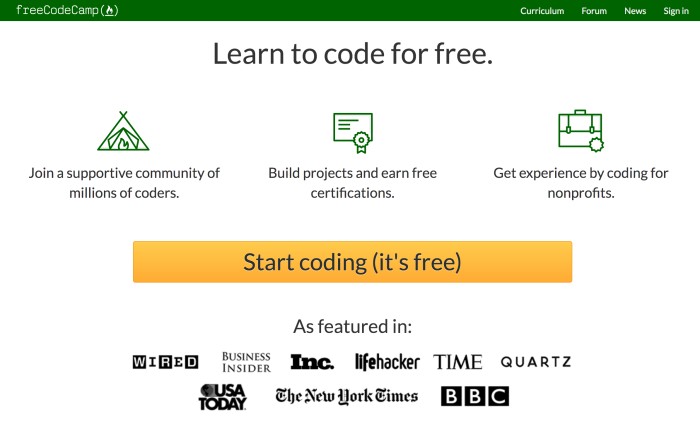
Remember: the more you play around with HTML, the more confident you will feel.
Once the basic structure and content is ready, start applying CSS rules to your page to make it look pretty.
And again: practice, practice, practice!
As soon as I finished a few simple front-end projects that were relevant to the jobs I was aiming for, I uploaded them to my UpWork profile.
And I can’t stress this enough:
Your first projects don’t have to be the best ones in the world at this point. They simply need to showcase how you can build something useful with your skills.
Having said that, I didn’t upload just any old project of mine.
Instead, I wanted to showcase projects that were similar to the solutions I would build for my first clients.
After all, if someone is looking to hire a WordPress developer, they don’t care how good your Python or Ruby skills are. Unless, of course, that WordPress website should work and look exactly like your last Python or Ruby project.
So, what should you do next?
As soon as you know the skills you want to learn, apply them to small, real-life projects of your own.
Even if you are entirely new to tech, make sure you don’t just watch online tutorials and expect to become a proficient developer overnight.
You must create stuff from scratch yourself. And the sooner you start doing that, the better.
Related posts:
- 17 JavaScript Projects You Can Build to Perfect Your Coding Skills
- Python Projects for Beginners: 10 Easy Python Programming Project Ideas
Step 4: Applying for small beginner level jobs
Once I had uploaded a couple of simple projects to my UpWork profile, it was time to start finding jobs.
And let me be honest here:
When I wrote my first freelance job applications, I was absolutely terrified – for two reasons:
- Firstly, because I thought I wasn’t good enough yet.
- Secondly, because I was afraid that someone would actually want to hire me.
This was a huge deal!
I was learning web dev skills just for fun. And now I was telling someone I could build stuff for them for money.
Obviously, I didn’t want to mess anything up with my first jobs.
I knew exactly what my skill level was like, so I wanted to avoid jobs that were too demanding, of course.
Therefore, I applied for the smallest, easiest front end web dev jobs I could find.
Literally, they were all just tiny little gigs where I would do small HTML or CSS adjustments on a blog website, for example.
And since I was familiar with the basics of WordPress, too, I knew I could manage easy WordPress jobs, too. You’d be surprised how many people need help with simple tasks, such as uploading a new logo or changing fonts.
So how do you find beginner-level jobs exactly?
You have two options here:
- Find work offline – Talk to friends, family, anyone you know. Someone might have heard of somebody who needs help with their website, for example.
- Find work online – I found this option easier to be honest. UpWork allowed me to find jobs worldwide, so there was more variety to choose from.
If you are using an online freelancing platform, do a quick search for the skills you are proficient in. Use a filter to find beginner-level jobs only.
On UpWork, you can search for beginner-level work by typing in a specific skill, such as WordPress, and filtering for entry-level jobs in the options on the left:
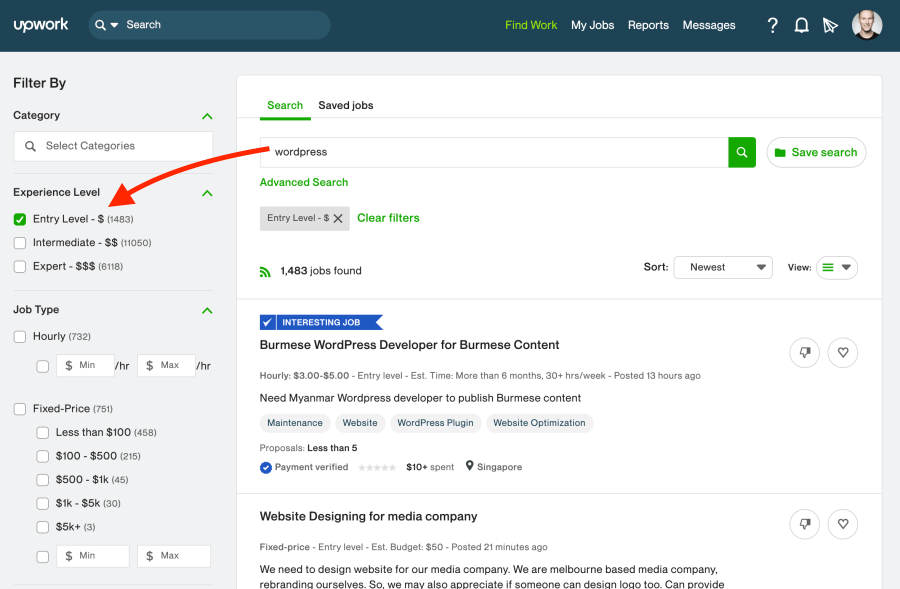
For example, here’s one of the first jobs I landed:
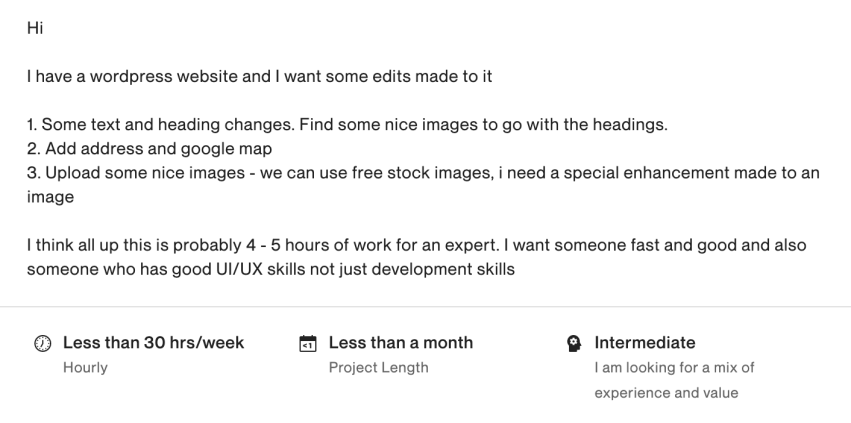
The client already had a WordPress website, and simply needed help with a few adjustments. Perfect!
One of the most frequent questions I get is:
How many applications do I need to send to get hired?
The answer: as many as it takes to get your first “yes”.
It’s impossible to know how long it will take until someone wants to hire you.
But know this: with each application you send, you are getting closer to your goal.
I sent out about 15 applications until I landed my first job.
It may sound like a lot of work, yes. But once you finish your first job and get your first positive review, things will get much easier.
And to get that first stellar review, you need to do everything do make sure your first client is happy. Let’s have a look:
Step 5: Delivering top-notch work
The first freelance job I got hired for was a simple WordPress gig on UpWork:

The client needed help with two things:
- Deleting pages that she didn’t need anymore.
- Adding her contact details to the Contact page.
She was looking for someone with low rates, and I was willing to help her at pretty much any rate. All I wanted was that first positive review on my UpWork profile.
To make sure she’d be 100% satisfied with my work, I followed these four guidelines:
- Communication – I made sure I replied to her questions promptly, explaining what would happen next, why my solution was good for her, and when she would hear from me next.
- Going the extra mile – We all love free goodies, right? I went the extra mile and installed two helpful WordPress plugins for my client that helped her manage the website more easily.
- Taking the deadline seriously – This is the most important point of all. If the client needs the job finished by tomorrow, you have to make sure you stick to the deadline – no matter what. I knew my work was part of a bigger project, so I needed to finish the job before the deadline so that other people could continue their work on the website after me.
- Making suggestions – Most clients aren’t familiar enough with coding or tech to know the best way of solving the problem they need help with. My client had great ideas, but it was my job to make sure she was aware of her options. I suggested easier solutions that were more sustainable and safe, and she was very happy to learn more about WordPress in general, too.
All in all, being a great freelancer boils down to one thing:
You have to know what your client wants, and deliver the best possible solution to their problem.
Also, you need to communicate like a professional. Make sure you explain things clearly enough so that anyone can understand what you’re saying.
Because the truth is: your clients aren’t familiar with the technical part of what you’re doing. Therefore, you have to make sure they know these three things:
- What you will be doing.
- Why your approach and solution are optimal for the job.
- When they will hear from you next, and when you will finish the job.
Step 6: Getting my first reviews
Ok, so I landed my first small gig, and did my best to make my client happy by following the tips we just covered.
Once I finished the job, here’s the review I received from her:

Seriously, I could not have asked for more.
Just like that, I earned my first 5-star review on UpWork, yay!
You can see that I wasn’t making a fortune with my first job. I offered a low rate just to land the job – because I needed that first positive review on my profile.
If you have been reading some of my freelancing articles, you know that this is a huge step for any beginning freelancer.
Once you have a positive review on your profile, potential clients trust you more.
Hence, it will be so much easier to land your next job.
And the more positive reviews you receive, the faster you can start making more money.
Also, those reviews will make you feel more confident in your skills.
Getting positive feedback from your clients is so empowering when you are just getting started. You will know that you are doing a good job, and that you are helping others with the skills you spent so much time learning and practising.
Here are just a couple of other reviews I received from some of the jobs that followed:
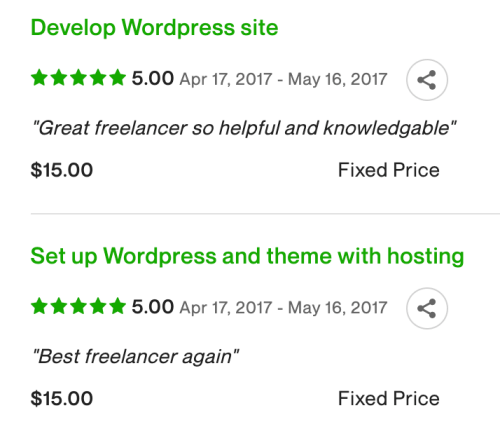
Ok, so it was clear that I could finish small entry-level gigs for clients who needed help with WordPress.
But the thing is:
Those small $15 jobs won’t pay your bills in the long run.
So the next step is to start applying for bigger, more demanding jobs.
Let’s have a look:
Step 7: Applying for bigger jobs
As soon as I felt confident enough in my skills, I started searching for more complex freelance gigs.
I had built 2 WordPress websites for myself at this point. Hence, I knew I could set up a simple WordPress website for a client, too.
Of course, it couldn’t be anything too difficult, because WordPress is a vast system with new features being added on a regular basis.
But there are surprisingly many entry-level jobs available, where you simply need to set up a basic website, create a few sub-pages, and help the client with the design and look of the website.
Most of these jobs are in the $200–500 range.
Remember: you need to take small steps towards earning more with each job.
You can’t jump from $15 jobs to making $5,000 from a single project overnight. You don’t want to overwhelm yourself with projects that may include tasks you can’t finish.
Hence, never overpromise.
So what would a good job look like at this point?
Look at this job posting, for example:
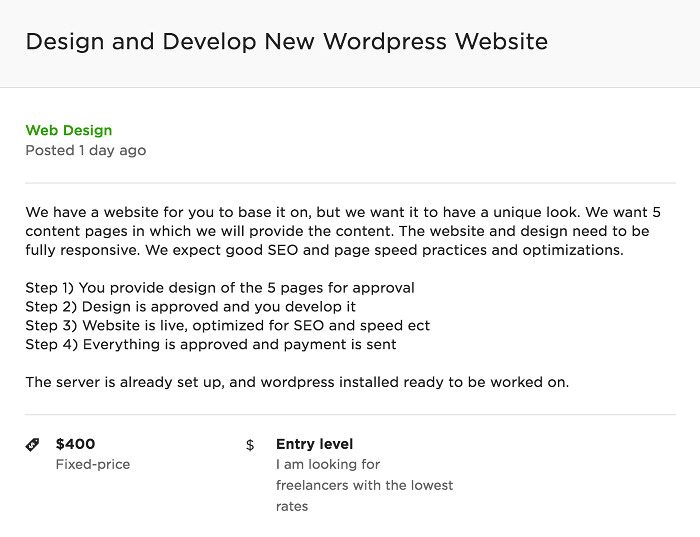
The client needs 5 pages, a cool design, some SEO work, a caching plugin, and that’s it.
They will even provide the content, so you can focus on building and customizing the design. Perfect!
Ok, the SEO work may be somewhat difficult if you are new to freelancing. But if you know the basics of how to configure a website to appear on Google, you are golden.
If SEO is a new topic for you, check out my Introduction to Search Engine Optimization – it’s perfect for beginners!
After searching for suitable jobs for a few days, I found this job opening on UpWork:
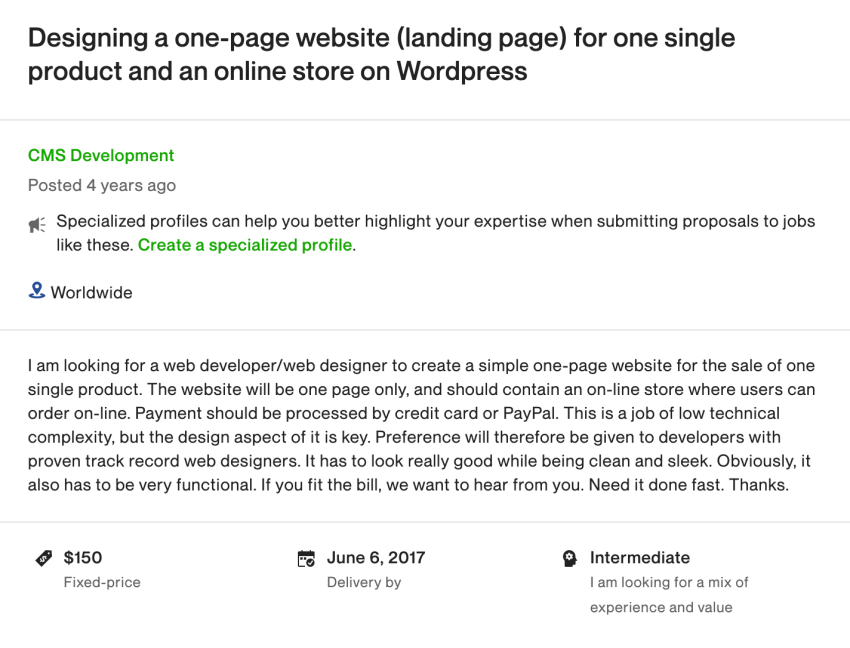
The client needed a simple WordPress web page to promote his own product.
The website needed to include a shop feature, which was super easy to set up with the free WooCommerce plugin for WordPress.
(I’m not sure how professional this sounds, but I learned how to use WooCommerce by watching a handful of tutorials on YouTube.)
The design had to be clean and simple, which sounded perfect.
And believe me or not, the $150 budget felt more than enough at that point.
I was still learning how to use WordPress, and this was a fantastic opportunity to learn new skills on a real-world project – while getting paid!
Once everything was finished, the client was happy with my work. He even paid a small $50 bonus, which made me feel like I was on the right track.
Step 8: Making my first $1,000
So how did I make my first $1,000 freelancing exactly?
So far, we looked at how I went from getting paid $15 to $200 from a single freelance gig.
And that’s all there is to it, really.
That first $200 job gave me enough confidence to apply for a $400 job, and so on.
The secret recipe: rinse and repeat.
Before I knew it, I got hired for my first $3,000 job with a client who offered me even more work after that project was finished.
It’s all about building your confidence and experience step-by-step.
You need to know where you stand with your skills, and make sure you never apply for jobs you can’t finish.
I know it’s difficult to know when you are ready for a more demanding job, though. All I can say is:
You have to keep improving your skills continuously.
The best way to learn more and practice your skills is to build and create projects on your own.
For example, if you enjoy front-end web development and WordPress, set up a WordPress website for yourself. Try things out, experiment with new features, and stay curious.
In short: explore the system one step at a time and get more familiar with the things it can do.
Also, browse job openings on freelancing platforms such as UpWork. Search for jobs in your niche, and pay attention to what the client needs.
Why?
Because that way you know what types of problems you need to solve for potential clients.
Hence, you can learn the exact right skills that help you land your next job.
Recap: How to start making money online as a freelance web developer
This article about how you can make your first $1,000 freelancing as a web developer was pretty long. I hope you are still with me!
Let’s recap:
- Do your research:
Make sure there’s demand for the skills you want to learn. Pay close attention to low-budget, beginner-level jobs. - Have realistic expectations:
Your first jobs will earn you some money, but your primary goal is to get your first positive review and become more confident in your skills. You are here to learn how to do freelance web development, and build projects for your portfolio. - Start with small gigs:
The smaller and easier the job, the better. Your first freelance gig needs to be easy enough for you to finish without any problems. - Deliver stellar work:
Communication is everything when it comes to making money freelancing. Listen to your client, and make sure you understand exactly what they need from you. Also, explain your solutions without any tech jargon – most clients aren’t familiar with the technical side of what we do. - Gather positive reviews:
Once you get your first 5-star review, it will be much easier to get hired again. When potential clients view your profile, positive reviews tell them that you are a reliable and skilled freelancer. - Find more demanding, higher-budget work step-by-step:
Once you feel confident enough, start searching for more complex jobs with higher rates. But again, be careful not to apply for jobs that are too difficult. Take baby steps and always make sure you can finish the job before applying.
As long as you don’t take on big jobs, you should be perfectly OK.
I know you want to make money freelancing, but you need to start small. You want to build up your reputation by earning those first 5-star reviews first.
The best way to get your first reviews is to keep your bid low.
This helps you land jobs more quickly, and you can increase your bid slowly as you go.
Once you get your first job, you will see that the next ones come much easier.
Hence, here’s an example scenario of how to make $1,000 freelancing online:
- Start with 5 jobs that pay $20 each = $100
- Carry on with 3 slightly more demanding jobs that pay $100 each = $300
- Finish 2 even more complex jobs that pay $300 each = $600
That’s a total of $1,000. And although the number of jobs is high, things will get easier.
Most likely, your first $20 job will take you just as long in total as your first $300 job.
Every freelancer goes through this initial phase of building up their experience and reputation.
All I can say is: it sounds like a lot of work, but you’re not here to make a fortune yet – you are here to learn how to be a successful freelancer.
Summing it up: How to make $1,000 freelancing online as a web developer
There you go! This is how I started my freelancing journey back in 2016 and 2017, and created a full-time job for myself that I couldn’t be happier with.
I went from knowing nothing about coding to running my own freelancing business in just 11 months.
I quit my soul-sucking office job that didn’t feel fulfilling at all, and started working when and where I wanted to.
Freelancing is my way of being in control of how I live my life.
I hope that the transparency in this article helps you on your freelancing journey, too.
Whether you are just barely starting to learn more about coding and web development, or whether you have a full-time developer job already and are looking for more freedom and flexibility, freelancing is definitely worth a shot.
If you are ready to take action and start right now, grab your copy of my popular beginner’s freelancing guide. It will show you how you can start making money from small freelance gigs, and leverage that into a full-time freelance career.
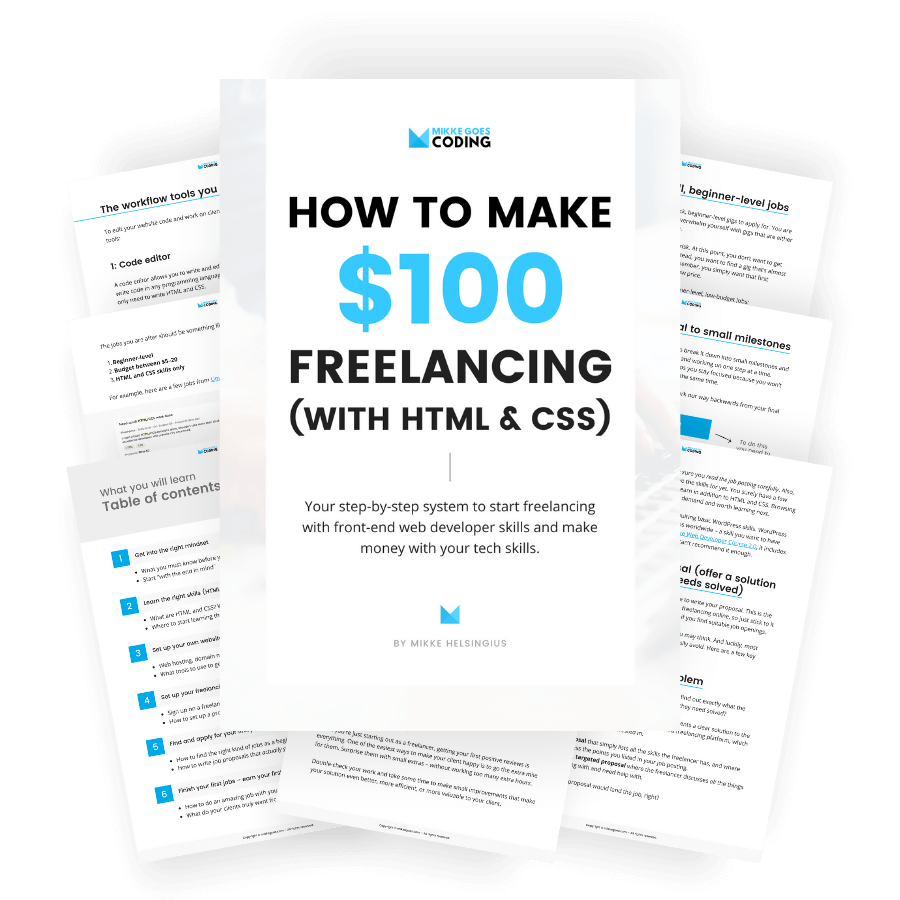
So what do you think? I’d love to hear from you in the comments below!
Have you tried freelancing, or are you entirely new to everything?
What’s your goal as a freelancer? More financial freedom and flexibility in life? Or something completely different?
I’d love to hear your thoughts! Please share them in the comments!
Looking forward to hearing from you 🙂
Now, for a more detailed beginner’s guide, check out my article on how to become a freelance web developer and make money online. I’ll see you there!
P.S. If you found this post helpful, share it with others! Thanks for your support!
Happy freelancing!
– Mikke
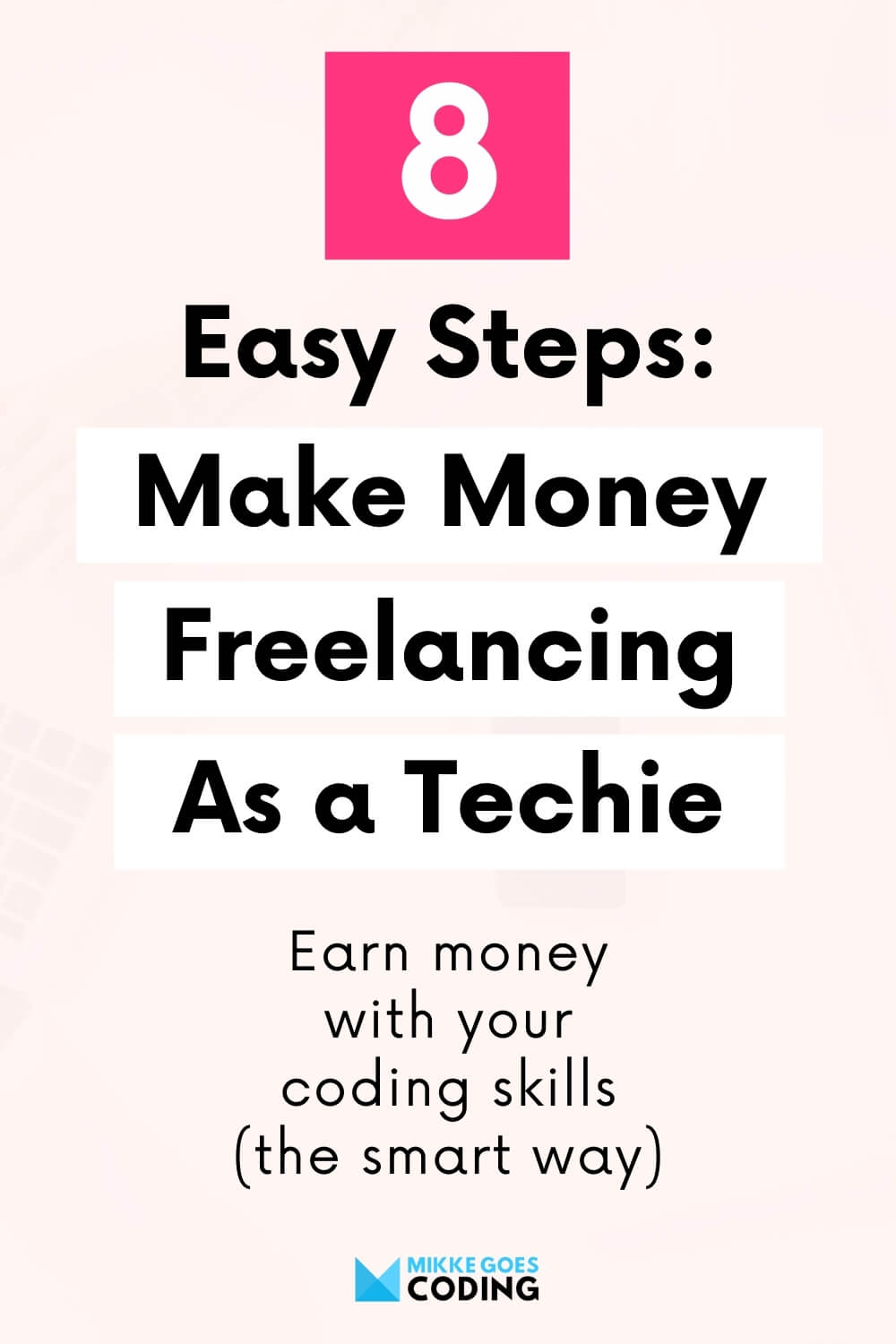
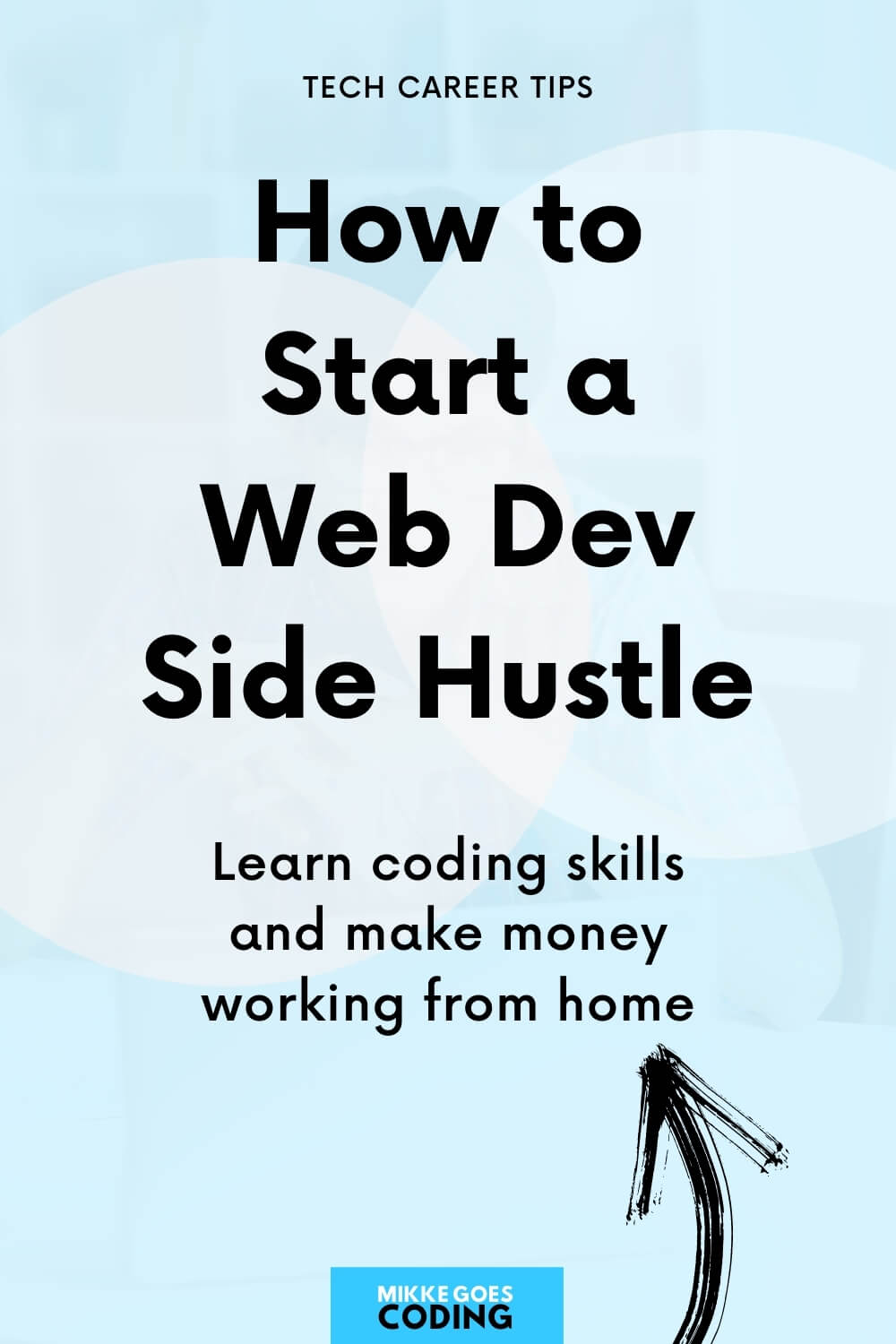



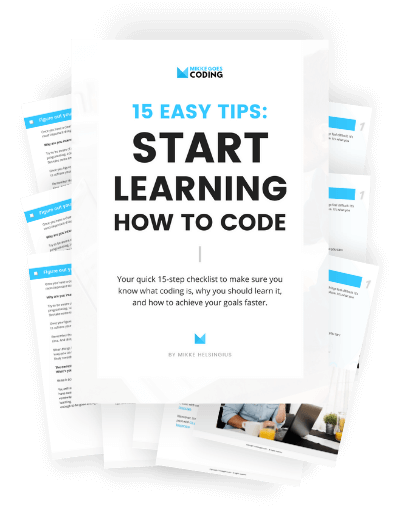
Thanks for the post. It had the information I was looking for. I want to follow your steps exactly as you described here. Cheers.